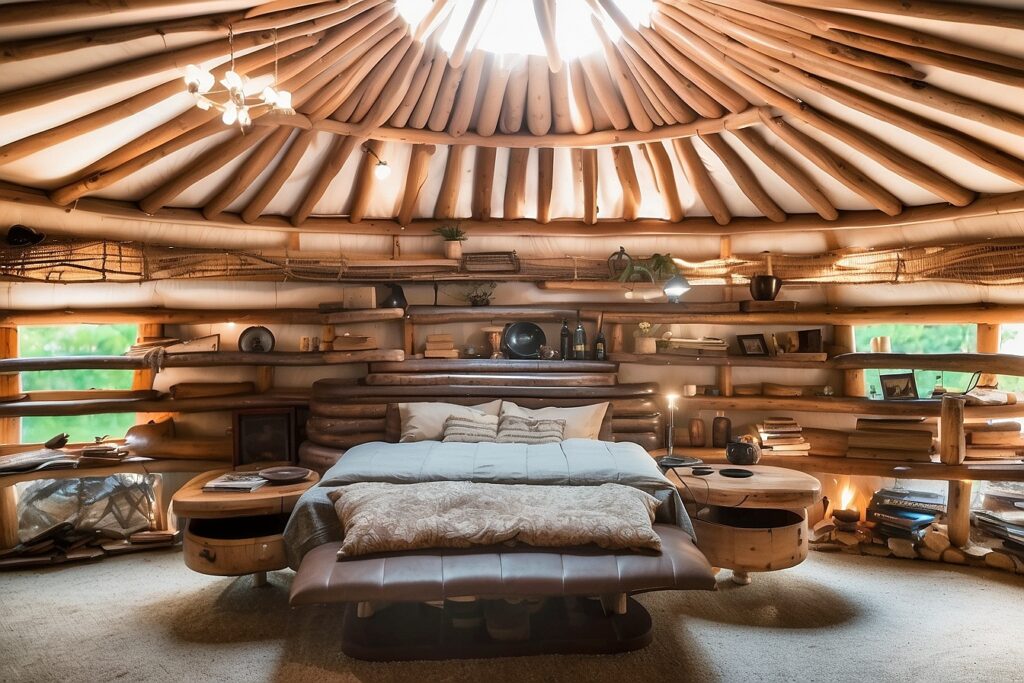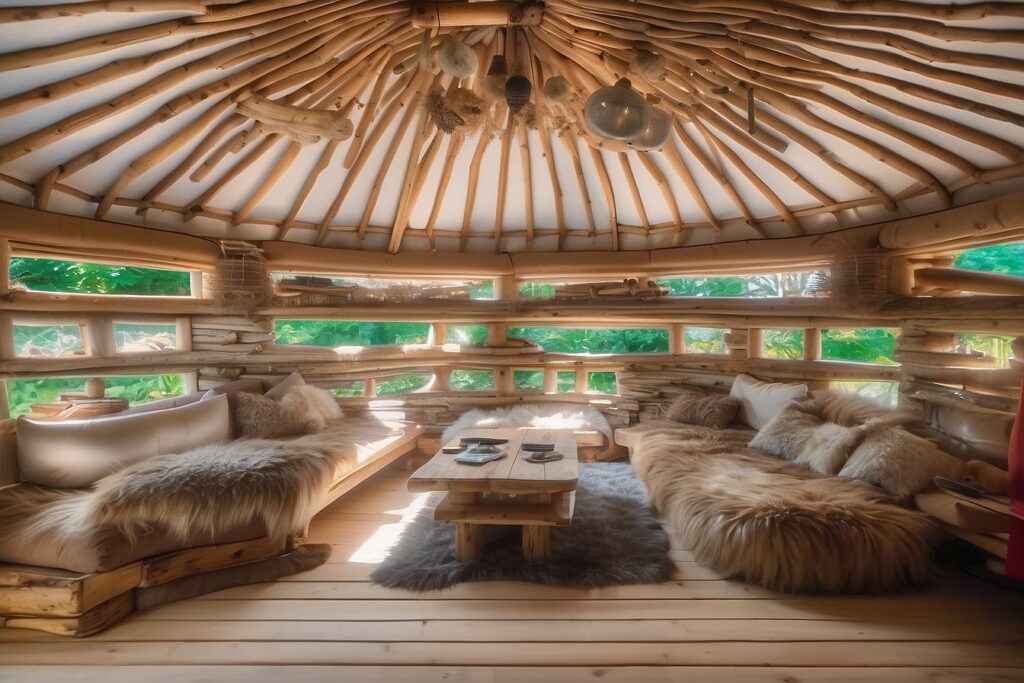
Exploring Unconventional Homes: Financing Challenges and Opportunities
In the realm of residential real estate, unconventional homes offer a unique appeal for those seeking something beyond the traditional brick-and-mortar structures. From Earthships to yurts, these alternative dwellings are not just ancient relics but modern-day options for those with a penchant for adventure and sustainability. However, delving into the realm of atypical housing comes with its own set of financing challenges. Let’s take a closer look at four types of unconventional properties and the financial considerations associated with them.
1. Yurts: Embracing Nomadic Roots
Originally crafted by nomadic tribes, yurts have transcended their historical roots to become a symbol of eco-friendly living and minimalist design. These circular tents, designed to be portable yet sturdy, offer a unique blend of tradition and modernity. In contemporary settings, yurts can be either anchored to a foundation or utilized as portable abodes akin to “glorified tents or big campers,” as described by Beasie Whaley, a real estate agent based in Montrose, CO.
Financing Challenges:
Securing financing for a yurt can present challenges due to its unconventional nature. Traditional mortgage lenders may be hesitant to extend loans for properties that deviate from standard housing norms. Yurts may not meet the criteria for conventional mortgages, leading borrowers to explore alternative financing options such as personal loans or specialty lenders catering to unique housing types.
2. Earthships: Sustainable Living Redefined
Earthships represent a paradigm shift in sustainable architecture, blending eco-conscious design principles with off-grid functionality. These self-sustaining dwellings utilize recycled materials, passive solar heating, and rainwater harvesting systems to minimize environmental impact. From tire walls to thermal mass construction, Earthships epitomize innovation in sustainable living.
Financing Challenges:
While Earthships offer long-term cost savings through reduced utility bills and environmental benefits, obtaining financing for these unconventional homes can be arduous. Mainstream lenders may lack familiarity with Earthship construction methods and off-grid infrastructure, posing obstacles to securing traditional mortgage loans. Prospective buyers may need to explore specialized lenders or alternative financing routes tailored to sustainable housing projects.
3. Log Cabins: Rustic Charm meets Modern Comfort
For those enamored with rustic aesthetics and natural surroundings, log cabins offer a timeless retreat from the hustle and bustle of urban life. With their classic appeal and sturdy construction, log cabins seamlessly blend into wooded landscapes, offering a serene escape for homeowners seeking solace in nature.
Financing Challenges:
While log cabins evoke nostalgia and charm, financing these properties can be complex due to factors such as remote locations, unique construction methods, and potential maintenance considerations. Traditional lenders may scrutinize log cabin properties more rigorously, considering factors such as accessibility, infrastructure, and resale potential. Buyers may need to demonstrate the property’s viability as a primary residence or vacation home to alleviate lender concerns.
4. Remote Locations: Off the Beaten Path
For adventurous souls seeking solitude and seclusion, remote properties beckon with the promise of unparalleled privacy and tranquility. Whether nestled in the mountains, tucked away in the wilderness, or perched on a secluded coastline, these off-grid retreats offer a chance to disconnect from the modern world and embrace the beauty of nature.
Financing Challenges:
Securing financing for remote properties presents unique challenges, including limited access to utilities, potential environmental hazards, and logistical complexities. Traditional lenders may view remote locations as higher-risk investments, requiring borrowers to provide comprehensive documentation regarding property access, infrastructure, and emergency services availability. Buyers may need to explore specialized lenders familiar with remote property financing or consider alternative funding sources to facilitate the purchase.
In conclusion, while unconventional homes such as yurts, Earthships, log cabins, and remote properties offer distinct advantages in terms of sustainability, aesthetics, and lifestyle, navigating the financing landscape can be daunting. Prospective buyers must be prepared to overcome challenges inherent in securing loans for nontraditional properties, whether through specialized lenders, alternative financing options, or diligent preparation and documentation. With careful planning and strategic approach, however, the dream of owning an unconventional home can become a reality, opening doors to a world of innovation, sustainability, and adventure.
Exploring Financing Options for Yurt Living: Overcoming Challenges
For those enchanted by the allure of yurt living, navigating the financial landscape can present a unique set of challenges. Unlike traditional homes, portable yurts often fall outside the purview of conventional mortgage lenders, requiring prospective buyers to explore alternative financing avenues.
1. Land Loans: Securing Space for Your Yurt
Given that portable yurts may not be recognized as traditional homes by lenders, financing options often center around acquiring land rather than the structure itself. Buyers may need to obtain a land loan to secure a suitable plot for their yurt, circumventing the need for traditional mortgage financing. Additionally, some yurt sellers may offer seller financing options, providing buyers with alternative pathways to homeownership.
2. Insurance Hurdles: Navigating Home Insurance Challenges
Securing adequate home insurance for yurts can prove to be a daunting task, with some insurers either unwilling or unable to provide coverage for these unconventional dwellings. Without proper insurance, yurt owners may face significant financial risks in the event of damage or loss. Prospective buyers should explore specialized insurers familiar with alternative housing options or seek creative solutions to mitigate insurance concerns.
3. DIY Yurt Construction: Building Your Dream Home
For those inclined towards a hands-on approach, building a yurt from scratch offers a cost-effective alternative to purchasing pre-built structures. Companies like Pacific Yurts provide kits containing materials and instructions for constructing your own yurt, offering a customizable and budget-friendly option for prospective homeowners. Financing the purchase of a yurt kit may be possible through personal loans, allowing buyers to spread out the cost over time while retaining control over labor and land acquisition.
Conclusion: Overcoming Financial Barriers to Yurt Ownership
While yurt living offers a blend of simplicity, sustainability, and flexibility, navigating the financial aspects of yurt ownership requires careful planning and resourcefulness. From securing land loans to addressing insurance challenges and exploring DIY construction options, prospective buyers must be proactive in finding creative solutions to overcome financing hurdles. With determination and strategic thinking, the dream of yurt living can become a reality, opening doors to a lifestyle imbued with adventure, connection to nature, and self-sufficiency.
Unveiling the World of Earthships: Sustainable Living Redefined
In the realm of eco-friendly architecture, Earthships stand as a beacon of innovation, embodying the principles of sustainability and self-sufficiency. These unique homes, constructed from rammed earth, recycled materials such as car tires, and bermed earth, offer a glimpse into a future where housing harmonizes with nature. Typically off-grid, Earthships harness renewable energy sources like solar panels and employ on-site sewage systems to minimize environmental impact. Their thick walls provide natural insulation, making them particularly suited to desert climates where passive heating and cooling are paramount.
Navigating Financing Challenges for Earthship Living
Despite their environmental merits, securing financing for Earthships can prove to be a formidable task. The unconventional construction materials and off-grid nature of these homes often preclude them from qualifying for traditional mortgage products. For instance, 203(k) rehab loans, designed to finance property improvements, may not be applicable to Earthship construction due to the absence of HUD-approved materials.
Finding Financial Solutions: A Case Study
Melina Winterton and Larry Peck’s journey to securing financing for their Earthship in Suffolk, VA, serves as a testament to the perseverance required in navigating the financing landscape for unconventional homes. Facing the challenge of obtaining funding for a home without traditional amenities such as a well, the couple encountered numerous hurdles in their quest for a loan. However, by leveraging their personal connections and cultivating a relationship with a local bank, Winterton and Peck were able to secure the financing needed to realize their Earthship dream.
The Power of Personal Relationships in Financing
Winterton emphasized the importance of personal relationships in securing financing for their Earthship. Their familiarity with the bank’s president and their established rapport with the lender played a pivotal role in gaining approval for the loan. This highlights the significance of working with local banks that possess a deeper understanding of Earthship construction and are situated in areas where similar homes have been successfully financed.
Refinement and Adaptation: Achieving Standard Assessment Requirements
While Winterton and Peck initially faced challenges in obtaining financing due to the unconventional nature of their Earthship, they eventually navigated the process successfully. By making improvements to their property to align with standard assessment requirements, including installing a well instead of relying solely on rainwater harvesting, they positioned themselves for refinancing with a national bank. This underscores the importance of adaptability and willingness to meet conventional standards to access broader financing options.
Conclusion: Pioneering Sustainable Living Through Innovative Financing
The story of Melina Winterton and Larry Peck exemplifies the resilience and resourcefulness required to finance an Earthship. Despite initial obstacles, their perseverance and strategic approach ultimately enabled them to secure financing and realize their vision of sustainable living. As interest in eco-friendly housing continues to grow, finding innovative financing solutions will be crucial in expanding access to Earthship living and fostering a more sustainable future for all.

Embarking on the Rustic Journey: Exploring Log Cabin Living
Nestled amidst the serene wilderness of northern landscapes, log cabins evoke images of cozy retreats and idyllic escapes into nature. Popular among hunters, outdoor enthusiasts, and those seeking respite from urban life, these rustic abodes offer a timeless charm and a connection to the great outdoors.
Addressing Financing Challenges for Log Cabins
While log cabins exude rustic charm, securing financing for these seasonal retreats can pose unique challenges. Many traditional lenders require extensive rehabilitation work to bring log cabins up to code before approving financing. Ashley Jaramillo, a seasoned real estate professional at Big Bear Real Estate in Troy, VT, highlights common deficiencies in seasonal cabins, including the lack of a heat source and insulation, rendering them unsuitable for year-round occupancy.
Exploring Financing Solutions: FHA 203(k) Rehab Loans
For buyers seeking conventional financing for log cabins, FHA 203(k) rehab loans offer a viable option. These loans enable borrowers to finance both the purchase price of the property and the cost of necessary renovations, making them ideal for addressing deficiencies such as the absence of a heat source. Jaramillo emphasizes the importance of installing adequate heating systems, noting that a fireplace alone may not suffice for year-round comfort.
Choosing Suitable Heating Options
To address the heating requirements of log cabins, Jaramillo recommends various heating solutions to ensure year-round comfort and energy efficiency. Electric baseboard heaters, Rinnai propane heaters, and oil-filled baseboard heaters are among the options available to log cabin owners. Electric baseboard heaters offer a simple and cost-effective solution, while propane heaters provide versatility and independence from traditional utilities. Oil-filled baseboard heaters, known for their efficiency, offer an eco-friendly alternative to electric heating systems.
Conclusion: Embracing the Charms of Log Cabin Living
Despite the challenges inherent in financing log cabins, the allure of rustic living amidst natural splendor continues to captivate individuals seeking solace and connection with nature. By exploring financing options such as FHA 203(k) rehab loans and investing in suitable heating solutions, prospective log cabin owners can embark on a journey of rustic living with confidence. As the demand for seasonal retreats and off-grid living experiences grows, finding innovative financing solutions will be essential in making log cabin dreams a reality for aspiring homeowners.




Наиболее трендовые новости индустрии.
Исчерпывающие эвенты всемирных подуимов.
Модные дома, бренды, haute couture.
Интересное место для модных хайпбистов.
https://rftimes.ru/news/2024-07-05-teplye-istorii-brend-herno